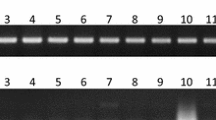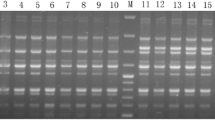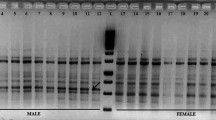Abstract
Genomic DNAs were isolated from both male and female plants ofAcer negundo L., by modified CTAB method of Doyle and Doyle for plant genomic DNA isolation and consequently tested with RAPD technique. Some sex-related specific oxyribonucleic acid bands were amplified by a group of decamer oligonucleotide random primers. This indicated that some genetic marks related to sexes of the species were found, which laid a foundation for sapling sex identification ofAcer negundo L.
Similar content being viewed by others
References
Chen Yuquan. 1995. Research Techniques of Biochemistry. Beijing: Publishing House of China Agriculture
Fu Rongzhaoet al. 1994. Handbook of Plant Genetic Transformation Techniques. Beijing: China Science and Technology Publishing House
Hormaza, J. I.et al. 1994. Identification of a RAPD marker linked to sex determination in Pistacia vera using bulked segregant analysis. Theor. Appl. Genet.,89:9–13.
Shen Renquanet al. 1993. Course of biochemistry. Beijing: Publishing House of Higher Education.
Author information
Authors and Affiliations
Additional information
Responsible editor: Chai Ruihai
Rights and permissions
About this article
Cite this article
Linsen, Z., Qiang, Z., Jinxia, M. et al. RAPD analysis on genomic DNA of male and female plants ofAcer negundo L. Journal of Forestry Research 10, 152–154 (1999). https://doi.org/10.1007/BF02855422
Received:
Issue Date:
DOI: https://doi.org/10.1007/BF02855422




